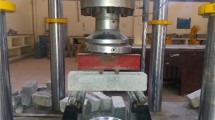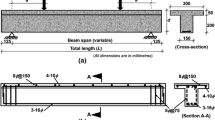Abstract
Adding steel fiber to concrete preparation to enhance residual strength and ductility is a potential solution to improve reliability of specific concrete members with compression–shear loading zones, such as deep beams, trusses and column joints, after exposure to high temperature. In this study, the primary aim is to explore the impact of steel fibers on concrete behaviors in shear failure under various exposure temperatures and normal stress. Compression–shear performance of steel fiber reinforced concrete was tested under several conditions of volume fraction of steel fibers (Vsf = 0, 1.0%, 1.5%, and 2.0%), exposure temperature (T = 20 °C, 200 °C, 400 °C, and 600 °C), and normal stress ratios (k = 0, 0.2, 0.4, 0.6, and 0.8), and compression–shear failure patterns and load–shear displacement curves were investigated. The results demonstrate that incorporation of steel fibers enhance ductile behavior of specimen under compression–shear loading, with a higher presence of friction traces and jagged edges appearing at shear interface. After temperature treatment above 400℃, the characteristics of tensile failure gradually disappear, while more crushed failure occurs. The peak shear strengths decrease significantly with the increase of exposure temperature. For different volume fraction of steel fibers (1.0%, 1.5%, and 2.0%), the shear strengths at 400 °C increase by 12.5%, 15.9%, and 11.1%, respectively. The optimal compression–shear strengthening effect is Vsf = 1.5%. Finally, according to the experimental results, the equivalent strength τoct − σoct theoretical calculation model is determined to be the most suitable compression–shear strength prediction of SFRC at various temperatures.











Similar content being viewed by others
References
Kodur V, Kumar P, Rafi MM (2020) Fire hazard in buildings: review, assessment and strategies for improving fire safety. PSU Res Rev 4(1):1–23. https://doi.org/10.1108/PRR-12-2018-0033
Ni S, Gernay T (2020) Predicting residual deformations in a reinforced concrete building structure after a fire event. Eng Struct 202:109853. https://doi.org/10.1016/j.engstruct.2019.109853
Qin D, Gao PK, Aslam F, Sufian M, Alabduljabbar H (2022) A comprehensive review on fire damage assessment of reinforced concrete structures. Case Stud Constr Mater 16:e00843. https://doi.org/10.1016/j.cscm.2021.e00843
Sharma A, Mishra KB (2021) Experimental investigations on the influence of ‘chimney-effect’ on fire response of rainscreen façades in high-rise buildings. J Build Eng 44:103257. https://doi.org/10.1016/j.jobe.2021.103257
Wróblewska J, Kowalski R (2020) Assessing concrete strength in fire-damaged structures. Constr Build Mater 254:119122. https://doi.org/10.1016/j.conbuildmat.2020.11912
Fernandes B, Gil AM, Bolina FL, Tutikian BF (2017) Microstructure of concrete subjected to elevated temperatures: physico-chemical changes and analysis techniques. J Rev IBRACON Estrut Mater 10:838–863. https://doi.org/10.1590/S1983-41952017000400004
Jia ZJ, Chen C, Shi JJ, Zhang YM, Sun ZM, Zhang PG (2019) The microstructural change of C-S-H at elevated temperature in Portland cement/GGBFS blended system. Cem Concr Res 123:105773. https://doi.org/10.1016/j.cemconres.2019.05.018
Düğenci O, Haktanir T, Altun F (2015) Experimental research for the effect of high temperature on the mechanical properties of steel fiber-reinforced concrete. Constr Build Mater 75:82–88. https://doi.org/10.1016/j.conbuildmat.2014.11.005
Wu HY, Lin XS, Zhou AN (2020) A review of mechanical properties of fibre reinforced concrete at elevated temperatures. Cem Concr Res 135:106117. https://doi.org/10.1016/j.cemconres.2020.106117
Liu JC, Tan KH, Yao Y (2018) A new perspective on nature of fire-induced spalling in concrete. Constr Build Mater 184:581–590. https://doi.org/10.1016/j.conbuildmat.2018.06.204
Liang XW, Wu CQ, Yang YK, Wu C, Li ZX (2019) Coupled effect of temperature and impact loading on tensile strength of ultra-high performance fibre reinforced concrete. Compos Struct 229:111432. https://doi.org/10.1016/j.compstruct.2019.111432
Moghadam MA, Izadifard RA (2019) Evaluation of shear strength of plain and steel fibrous concrete at high temperatures. Constr Build Mater 215:207–216. https://doi.org/10.1016/j.conbuildmat.2019.04.136
Khan M, Cao ML, Xie CP, Ali M (2022) Experimental and analytical study of hybrid fiber reinforced concrete prepared with basalt fiber under high temperature. Fire Mater 46(1):205–226. https://doi.org/10.1002/fam.2968
Li L, Khan M, Bai CY, Shi K (2021) Uniaxial tensile behavior, flexural properties, empirical calculation and microstructure of multi-scale fiber reinforced cement-based material at elevated temperature. Materials 14(8):1827. https://doi.org/10.3390/ma14081827
Bezerra ACS, Maciel PS, Corrêa ECS, Soares Junior PRR, Aguilar MTP, Cetlin PR (2019) Effect of high temperature on the mechanical properties of steel fiber-reinforced concrete. Fibers 7(12):100. https://doi.org/10.3390/fib7120100
Kim S, Oli T, Park C (2020) Effect of exposure to high temperature on the mechanical properties of SIFRCCs. Appl Sci 10(6):2142. https://doi.org/10.3390/app10062142
Yang HF, Lu XC, Gong MC, Yang P (2023) Compression–shear performance of steel fiber reinforced rubber concrete. J Build Eng 75:106977. https://doi.org/10.1016/j.jobe.2023.106977
Alimrani NS, Balazs GL (2021) Effect of steel fibres on concrete at different temperatures in terms of shear failure. Mag Concr Res 73(21):1113–1124. https://doi.org/10.1680/jmacr.19.00479
Moghadam MA, Izadifard RA (2021) Prediction of the tensile strength of normal and steel fiber reinforced concrete exposed to high temperatures. Int J Concr Struct Mater 15(1):47. https://doi.org/10.1186/s40069-021-00485-6
Chen GM, Yang H, Lin CJ, Chen JF, He YH, Zhang HZ (2016) Fracture behaviour of steel fibre reinforced recycled aggregate concrete after exposure to elevated temperatures. Constr Build Mater 128:272–286. https://doi.org/10.1016/j.conbuildmat.2016.10.072
Serrano R, Cobo A, Prieto MI, María DLNG (2016) Analysis of fire resistance of concrete with polypropylene or steel fibers. Constr Build Mater 122:302–309. https://doi.org/10.1016/j.conbuildmat.2016.06.055
Ahmad S, Rasul M, Adekunle SK, Al-Dulaijan SU, Maslehuddin M, Ali SI (2019) Mechanical properties of steel fiber-reinforced UHPC mixtures exposed to elevated temperature: effects of exposure duration and fiber content. Compos Part B Eng 168:291–301. https://doi.org/10.1016/j.compositesb.2018.12.083
Zhang D, Tan GY, Tan KH (2021) Combined effect of flax fibers and steel fibers on spalling resistance of ultra-high performance concrete at high temperature. Cem Concr Compos 121:104067. https://doi.org/10.1016/j.cemconcomp.2021.10406
Li L, Zhang RB, Jin L, Du XL, Wu J, Duan WH (2019) Experimental study on dynamic compressive behavior of steel fiber reinforced concrete at elevated temperatures. Constr Build Mater 210:673–684. https://doi.org/10.1016/j.conbuildmat.2019.03.138
Qian K, Liang SL, Fu F, Li Y (2021) Progressive collapse resistance of emulative precast concrete frames with various reinforcing details. J Struct Eng 147(8):04021107. https://doi.org/10.1061/(ASCE)ST.1943-541X.0003065
Yu ZP, Huang Q, Xie XH, Xiao N (2018) Experimental study and failure criterion analysis of plain concrete under combined compression–shear stress. Constr Build Mater 179:198–206. https://doi.org/10.1016/j.conbuildmat.2018.05.242
Liao Q, Su YR, Yu JT, Yu KQ (2022) Compression–shear performance and failure criteria of seawater sea-sand engineered cementitious composites with polyethylene fibers. Constr Build Mater 345:128386. https://doi.org/10.1016/j.conbuildmat.2022.12838
Guo YH, Liu JH, Li ZY (2008) Study on compression–shear failure of steel fiber reinforced concrete. J Build Mater 4(2):152–156. https://doi.org/10.3969/j.issn.1007-9629.2008.02.005
Wang JR, Xie FX, Zhang CL, Ruan J (2020) Experimental study and failure criterion analysis on combined compression–shear performance of self-compacting concrete. Materials 13(3):713. https://doi.org/10.3390/ma13030713
Wang ZL, Yang D, Wang JG (2011) Study on behaviour and strength of SFRC under combined action of compression and shear. Mag Concr Res 63(11):929–836
Wang YM, Deng ZH, Xiao JZ, Li T, Li J (2021) Mechanical properties of recycled aggregate concrete under compression–shear stress state. Constr Build Mater 271:121894. https://doi.org/10.1016/j.conbuildmat.2020.121894
Yang HF, Yang QM, Luo JH, Jiang JS, Mei JJ, Liu AR (2023) Shear strength and failure criterion of geopolymer coral aggregate concrete under compression–shear loading. J Build Eng 76:107241. https://doi.org/10.1016/j.jobe.2023.107241
Deng ZH, Li ZH, Yang HF, Li J (2019) Mechanic behavior of recycled aggregate concrete subjected to compression–shear loading. J Build Struct 40:174–180
Liu B, Geng SY, Li Z, Guo JH, Deng ZH, Qian K (2021) Experimental and modeling research on compression–shear behavior of carbon fiber reinforced coral concrete. Constr Build Mater 301:124347. https://doi.org/10.1016/j.conbuildmat.2021.124347
Liu B, Zhou JK, Wen XY, Guo JH, Deng ZH, Hu X (2021) Mechanical performance and failure criterion of coral concrete under combined compression–shear stresses. Constr Build Mater 288:123050. https://doi.org/10.1016/j.conbuildmat.2021.123050
Lei B, Yu HC, Guo YP, Zhao HB, Wang KJ, Li WG (2023) Mechanical properties of multi-recycled aggregate concrete under combined compression–shear loading. Eng Fail Anal 143:106910. https://doi.org/10.1016/j.engfailanal.2022.106910
Ahmad S, Bhargava P, Chourasia A, Usmani A (2020) Effect of elevated temperatures on the shear-friction behaviour of concrete: experimental and analytical study. Eng Struct 225:111305. https://doi.org/10.1016/j.engstruct.2020.111305
Krahl PA, Pereira MF, Dalfré GM, Siqueira GH (2020) A novel approach to characterize the direct shear pullout behavior of single hooked steel fibers. Cem Concr Compos 113:103685. https://doi.org/10.1016/j.cemconcomp.2020.103685
Hoang AL, Fehling E (2017) Influence of steel fiber content and aspect ratio on the uniaxial tensile and compressive behavior of ultra high performance concrete. Constr Build Mater 153:790–806. https://doi.org/10.1016/j.conbuildmat.2017.07.130
Fan KJ, Li JB, Yu M, Wu M, Yao Y (2022) Compressive stress-strain relationship for stressed concrete at high temperatures. Fire Saf J 130:103576. https://doi.org/10.1016/j.firesaf.2022.103576
EaH A, Bakar BHA, Alshaikh IMH, Zeyad AM, Altheeb A, Alghamdi H (2021) Experimental investigation on fracture characteristics of plain and rubberized concrete containing hybrid steel-polypropylene fiber. Structures 33:4421–4432. https://doi.org/10.1016/j.istruc.2021.07.011
Liu YW, Shi CJ, Zhang ZH, Li N, Shi D (2020) Mechanical and fracture properties of ultra-high performance geopolymer concrete: effects of steel fiber and silica fume. Cem Concr Compos 112:103665. https://doi.org/10.1016/j.cemconcomp.2020.103665
Zhang Y, Ju JW, Chen Q, Yan ZG, Zhu HH, Jiang ZW (2020) Characterizing and analyzing the residual interfacial behavior of steel fibers embedded into cement-based matrices after exposure to high temperatures. Compos Part B Eng 191:107933. https://doi.org/10.1016/j.compositesb.2020.107933
Ding YN, Zhang C, Cao ML, Zhang YL, Azevedo C (2016) Influence of different fibers on the change of pore pressure of self-consolidating concrete exposed to fire. Constr Build Mater 113:456–469. https://doi.org/10.1016/j.conbuildmat.2016.03.070
Bresler B, Pister KS (1958) Strength of concrete under combined stresses. J Proc 55(9):321–345
Willam KJ (1974) Constitutive model for the triaxial behavior of concrete. IABSE Seminar on Concrete Structure subjected Triaxial Stresses, pp 1–30
Guo ZH, Wang CZ (1991) Investigation of strength and failure criterion of concrete under multi-axial stresses. China Civ Eng J 24(3):1–14
Xie FX, Cai DP, Ji L, Zhang CL, Ruan J, Lei X (2021) Combined compression–shear performance and failure criteria of internally cured concrete with super absorbent polymer. Constr Build Mater 266:120888. https://doi.org/10.1016/j.conbuildmat.2020.120888
Lin BT, Jin Y, Pang HW, Cerato AB (2016) Experimental investigation on dilation mechanisms of land-facies Karamay oil sand reservoirs under water injection. Rock Mech Rock Eng 49:1425–1439. https://doi.org/10.1007/s00603-015-0817-8
Drucker DC, Prager W (1952) Soil mechanics and plastic analysis or limit design. Q Appl Math 10(2):157–165
Acknowledgements
This study was supported by the National Natural Science Foundation of China (No.52178123), and Guangxi Natural Science Foundation (No. 2023GXNSFAA026178). The sponsorships are gratefully acknowledged.
Author information
Authors and Affiliations
Contributions
Methodology: Haifeng Yang. Formal analysis and investigation: Jinhai Luo, Chengli Liu. Writing-original draft preparation: Jinhai Luo, Qingmei Yang. Writing-review and editing: Haifeng Yang. Funding acquisition: Haifeng Yang.
Corresponding author
Ethics declarations
Competing interests
The authors declare that they have no known competing financial interests or personal relationships that could have appeared to influence the work reported in this paper.
Additional information
Publisher's Note
Springer Nature remains neutral with regard to jurisdictional claims in published maps and institutional affiliations.
Rights and permissions
Springer Nature or its licensor (e.g. a society or other partner) holds exclusive rights to this article under a publishing agreement with the author(s) or other rightsholder(s); author self-archiving of the accepted manuscript version of this article is solely governed by the terms of such publishing agreement and applicable law.
About this article
Cite this article
Yang, H., Luo, J., Yang, Q. et al. Shear strength and failure criterion analysis of steel fiber reinforced concrete exposed to elevated temperature under combined compression–shear loading. Mater Struct 57, 99 (2024). https://doi.org/10.1617/s11527-024-02362-6
Received:
Accepted:
Published:
DOI: https://doi.org/10.1617/s11527-024-02362-6




